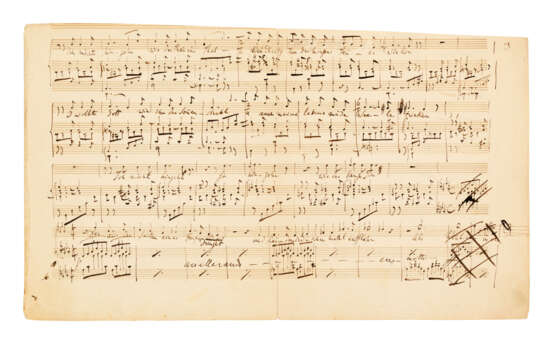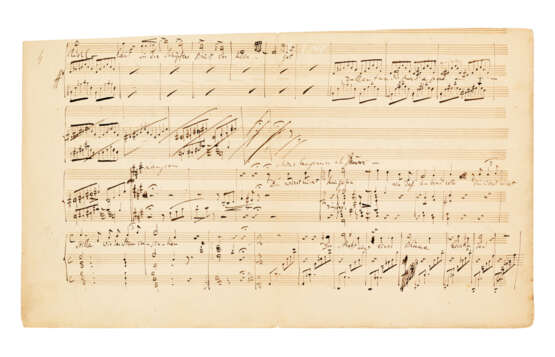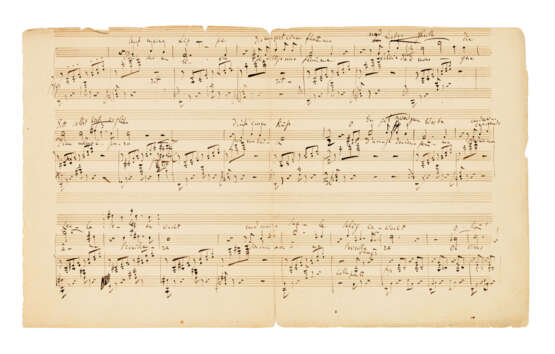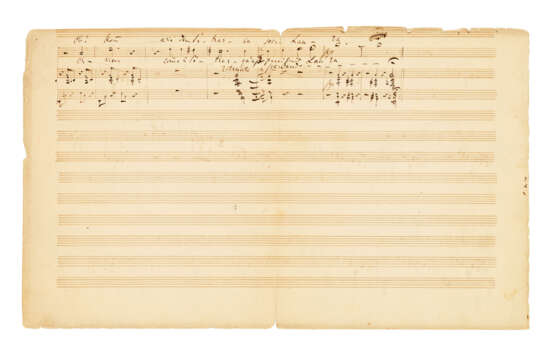ID 381240
Lot 33 | Franz Liszt (1811-1886)
Estimate value
£ 6 000 – 9 000
3¼ pages on two leaves, 192 and 196 x 300mm, the paper cut down from larger sheets, ruled with 12 staves per page, scored for voice and piano, four systems of three staves per page except for the final page, 104 bars (9 of which cancelled), pages 1 and 2 marked ‘3’ and ‘4’ in autograph, autograph cancellations and emendations (worn and split along central vertical fold and a little tattered at the horizontal margins of the second leaf, erasure marks).
Text by Georg Herwegh, in German, from the poem Strophen aus der Fremde, stanzas 4-6 out of 7 in total.
Provenance: From the same ownership as lot 32, an autograph draft for the song ‘Oh! quand je dors’: corresponding creases indicate that the two were stored folded together for some time.
‘Ich möchte hingehn’: a compositional draft from the period in which the composer gathered together – and revised – earlier works for publication by Schlesinger in the Gesammelte Lieder. ‘Ich möchte hingehn’ – a composition that originated in 1845 – is one of Liszt’s better-known songs, partly by virtue of the resemblance that exists between a single bar of the work and the opening motif of Wagner’s Tristan und Isolde, composed more than a decade later. In fact, Liszt was quoting from Wagner: a handful of manuscripts for ‘Ich möchte hingehn’ are known to survive and only one of these incorporates the bar in question, added on a pasted-on slip to a copyist manuscript by Liszt around 1858, after he had been shown the Tristan score by Wagner and heard it performed (for the most recent discussion of the Tristan motif, see Nineteenth-Century Music: Selected Proceedings of the Tenth International Conference, eds. J. Samson and B. Zon (2017)). The present manuscript dates from roughly the same period, when Liszt was revising certain of his earlier songs for the 1859 volume of the Gesammelte Lieder; another incomplete draft for ‘Ich möchte hingehn’ from this time is held as part of the Frederick R. Koch collection at Yale’s Beinecke Library (GEN MSS 601). That multiple compositional drafts for this song exist illustrates the way in which Liszt worked on his Lieder, continually revising them across the years until they became, essentially, new works, often unrecognisable from the original versions (for more on this process see Rena C. Mueller, ‘The Lieder of Franz Liszt’, in The Cambridge Companion to the Lied (2004), pp. 168-84). After entering into an agreement with Schlesinger in the mid-1850s to prepare a collected edition of his songs – published as the Gesammelte Lieder between 1855 and 1859 – Liszt revisited earlier songs such as ‘Ich möchte hingehn’, many of which originated in the 1840s; what began as fair copies soon became compositional drafts, as he started to revise them as he progressed. During this process, between 1856 and 1859, Liszt used paper originally meant for orchestral music, cut down or torn from larger sheets, as here.
Christie's is grateful to Professor Rena Charnin Mueller for her advice on the present lot.
| Address of auction |
CHRISTIE'S 8 King Street, St. James's SW1Y 6QT London United Kingdom | |
|---|---|---|
| Preview |
| |
| Phone | +44 (0)20 7839 9060 | |
| Buyer Premium | see on Website | |
| Conditions of purchase | Conditions of purchase |






